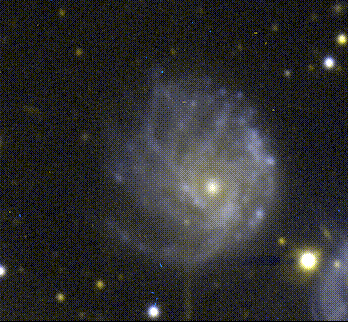 The giant, asymmetric spiral galaxy NGC 2276. This is an exceptionally
bright Sc I galaxy, with one of the highest measured star-formation
rates among "normal" galaxies. Its asymmetry (with what look like
a leading and trailing or upstream and downstream edge) rated it
an appearance in the Arp Atlas, both individually (number 25) and
as a wide pair with the elliptical galaxy NGC 2300 (number 114).
Concomitant with the high star formation rate inferred from H-alpha
emission, NGC 2276 has had several observed supernovae throughout this
century - most of them along the prominent western rim of star-forming
regions. The NGC 2276/2300 pair (or group, with some other faint
galaxies) achieved notoriety with the detection by Mulchaey et al.
(using the ROSAT X-ray observatory) of hot, diffuse gas bound to the
group but not to the individual galaxies, suggesting a very large
total mass for this sparse grouping and by implication the many others
like it. We're collecting ROSAT high-resolution HRI, new optical and
deep VLA data on this one, so stand by for more details...
The giant, asymmetric spiral galaxy NGC 2276. This is an exceptionally
bright Sc I galaxy, with one of the highest measured star-formation
rates among "normal" galaxies. Its asymmetry (with what look like
a leading and trailing or upstream and downstream edge) rated it
an appearance in the Arp Atlas, both individually (number 25) and
as a wide pair with the elliptical galaxy NGC 2300 (number 114).
Concomitant with the high star formation rate inferred from H-alpha
emission, NGC 2276 has had several observed supernovae throughout this
century - most of them along the prominent western rim of star-forming
regions. The NGC 2276/2300 pair (or group, with some other faint
galaxies) achieved notoriety with the detection by Mulchaey et al.
(using the ROSAT X-ray observatory) of hot, diffuse gas bound to the
group but not to the individual galaxies, suggesting a very large
total mass for this sparse grouping and by implication the many others
like it. We're collecting ROSAT high-resolution HRI, new optical and
deep VLA data on this one, so stand by for more details...
This color composite is from images taken in blue, and near-infrared (BI) filters, using a CCD at the 1.1-meter Hall telescope of Lowell Observatory, by Bill Keel. It covers a region 3.9 arcminutes across. The bright feature to the southwest (lower right) is scattered light from a bright SAO star just outside the field of view. This can be a troublesome galaxy to observe with some equatorially-mounted telescopes, lying within 5 degrees of the north celestial pole.
 UA Astronomy Home Page
UA Astronomy Home Page